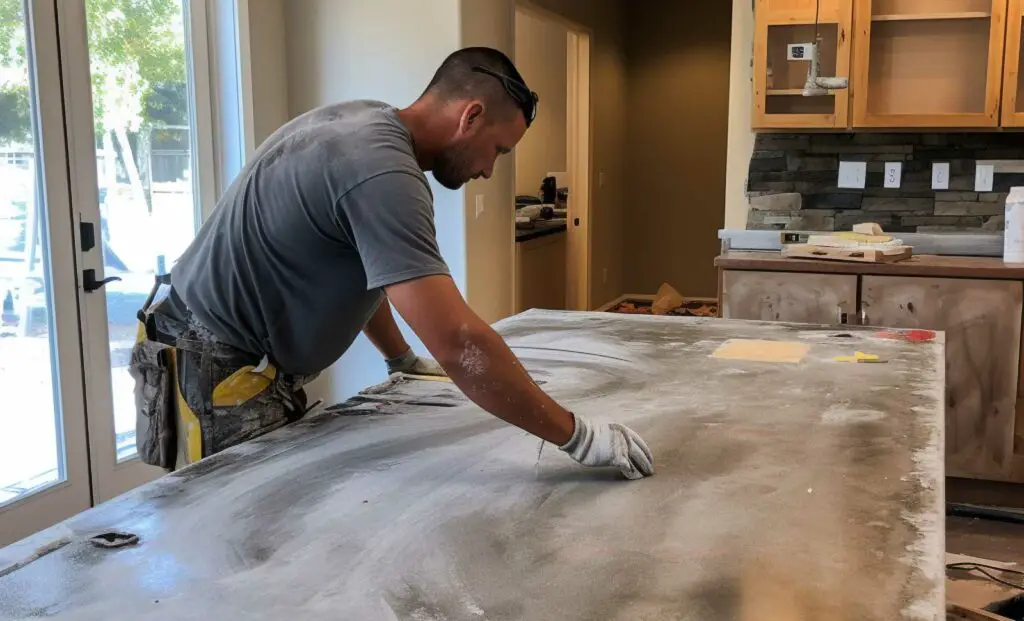Installation of your concrete countertops not go quite how you planned? Do you want to know how to fix them and make them smooth again? In this article, we will guide you through the steps to repair your rough concrete countertops and make them look as good as new.
There are several methods you can use to fix rough concrete countertops, including sanding, grinding, and applying a skim coat. Each method has its own benefits and drawbacks, so it is important to choose the method that is best suited for your specific situation. We will go over each method in detail and provide tips to help you achieve the best results.
- Proper preparation is key to fixing rough concrete countertops.
- There are several different ways and methods to fix roughness, including sanding, grinding, and applying a skim coat.
- Sealing your concrete countertops is important to protect them from damage and maintain their appearance.

How to Fix Rough Concrete Countertops
If your concrete countertops are rough that means they didn’t get finished properly, and now you want to know how to fix them. Fortunately, there are some simple steps you can take to smooth out the surface.
Explanation of Why Concrete Countertops Can Become Rough
It’s easy to get caught up in the videos you see on YouTube that make it look so easy to set up concrete counter tops. The one that did it for me was one where they were setting up concrete counter tops with an acid stain for an outdoor kitchen.
For some reason, I thought it was a good idea to pour my own DIY concrete countertops. I quickly learned that there was a lot more to it than what I’d originally thought.
But you can learn from my mistakes and get your own concrete countertops to that high-polish finish you’re looking for.
I had a really hard time, not only getting things poured and leveled, but the hardest part was getting a flat, even, smooth surface. But after much time with a grinder and a palm sander (and a LOT of disks and different grits of sandpaper) I was able to get the finish I was looking for.
Probably the biggest cause of a rough surface on your new countertops improper finishing during the installation process. If the concrete was not properly troweled or floated, it can leave a rough surface that is prone to chipping and cracking – and it will.
First Things First: Fixing Rough Concrete Counters
If you have rough concrete countertops, there are a few immediate steps you can take to improve their appearance and texture:
- Clean the surface: The first step to fixing rough concrete countertops is to clean the surface thoroughly. Use a mild detergent and warm water to remove any dirt and debris from the surface. Rinse the surface thoroughly with clean water and allow it to dry completely.
- Sand the surface: Once the surface is clean and dry, you can begin sanding. Use a fine-grit sandpaper to sand the surface of the concrete, working in a circular motion. Be sure to sand the entire surface evenly to avoid creating low spots or high spots.
- Apply a concrete sealer: After sanding, it is important to apply a concrete sealer to protect the surface and give it a smooth, glossy finish. Choose a sealer that is specifically designed for use on concrete countertops.
Air Bubbles: The Unseen Enemy
One thing you don’t know until you take off your form sides is whether or not you were successful in getting all the air bubbles out.
You followed the instructions about tapping your forms all the way around to remedy this issue, but still, you’ll only be see the results once you remove those form sides, and sometimes, despite your best efforts, it just doesn’t work how you hoped. At this point, the only way to solve this is to do some patch work with a putty knife and some additional countertop material.
How do I know? Because that’s what happened to me.
Once I pulled the forms off, I had one corner on my island where the fit was ever so slightly awkward. There really wasn’t anything I could do about it, but I knew I could work it out and get it where I wanted after the form was off. But the concrete had completely set. So I did exactly what I talked about here – mixed a small batch of patch material, and started filling in the voids with a small trowel.
Once you’ve filled the voids left (hopefully your patch work is only needed in small sections) by the air bubbles and it’s fully set and dry, you’re ready for sanding.
By following these steps, you can improve the appearance and texture of your rough concrete countertops. However, if the surface is severely damaged or if you are unsure about how to proceed, it’s never a bad idea to bring in a professional if the fix is more than you can handle.
Remember, prevention is the best cure. To avoid rough concrete countertops in the future, make sure to properly finish the surface during installation and take care to avoid scratching or scuffing the surface. With proper care and maintenance, your concrete countertops can last for many years to come.
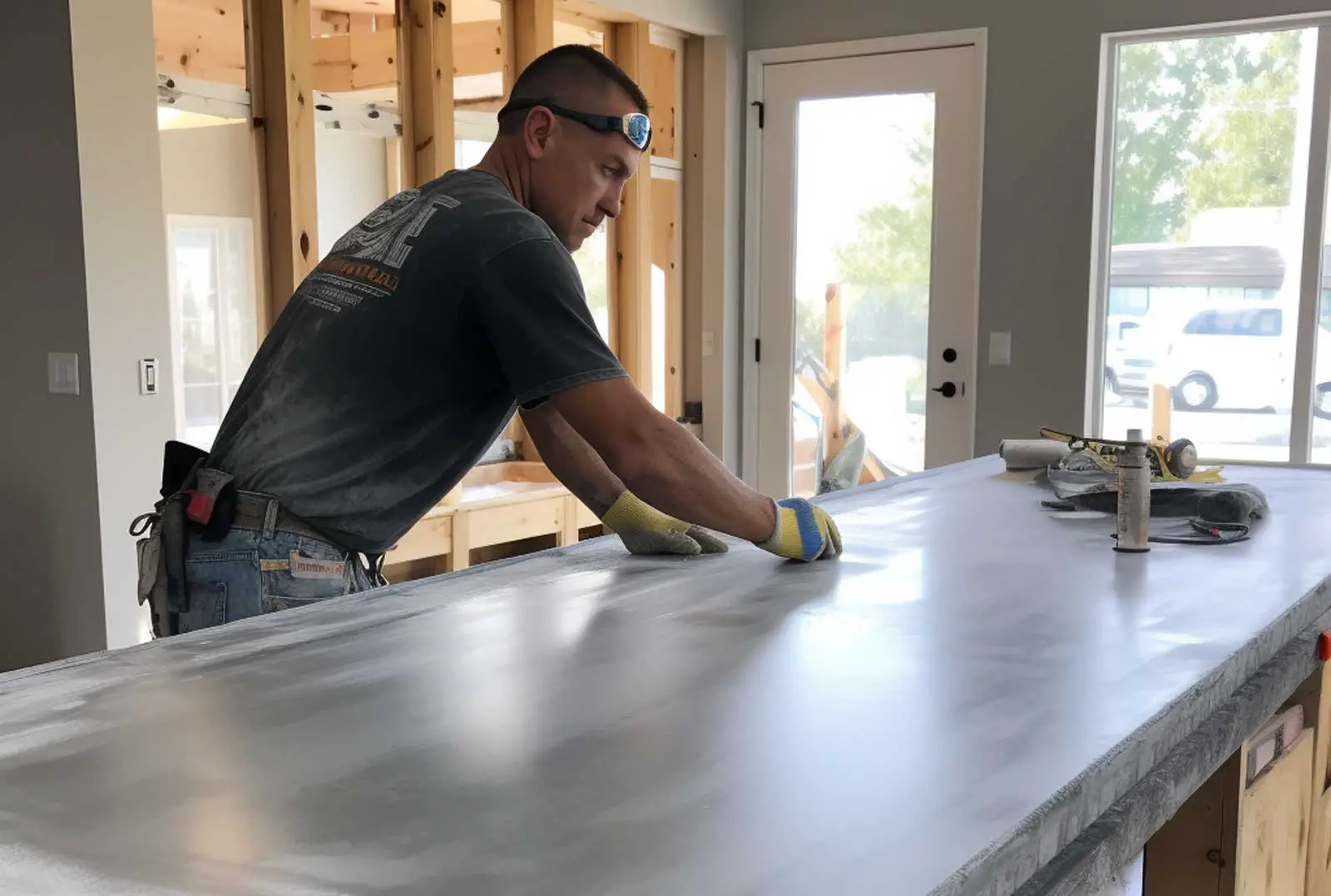
Preparation Before Repair
Before you start fixing your rough concrete countertop, it’s important to prepare the surface properly. This will help ensure that the repair is successful and long-lasting. Here are some steps you should follow:
Cleaning the Countertop and Assessing the Extent of Roughness and Damage
The first step is to clean the countertop surface thoroughly. Use a mixture of warm water and mild soap to remove any dirt, grime, or grease. You can also use a degreasing cleaner for tougher stains. Rinse the surface with clean water and let it dry completely.
Once the surface is clean, assess the extent of roughness and damage. Use your hand to feel the surface and identify any rough spots. Also, look for any cracks, chips, or other damage. This will help you determine the best way to repair the surface.
If the roughness is minor, you can use sandpaper to smooth out the surface. Start with a coarse grit sandpaper and gradually move to a finer grit until the surface is smooth. If the roughness is more severe, you may need to use a concrete grinder to smooth out the surface.
If there are cracks or chips, you will need to fill them in with a concrete patching compound. Make sure to follow the manufacturer’s instructions when mixing and applying the compound. You may need to use a trowel or putty knife to apply the compound and smooth out the surface.
Cleaning the countertop and assessing the extent of roughness and damage is an essential step in preparing the surface for repair. By following these steps, you can ensure that your repair is successful and your countertop looks as good as new.
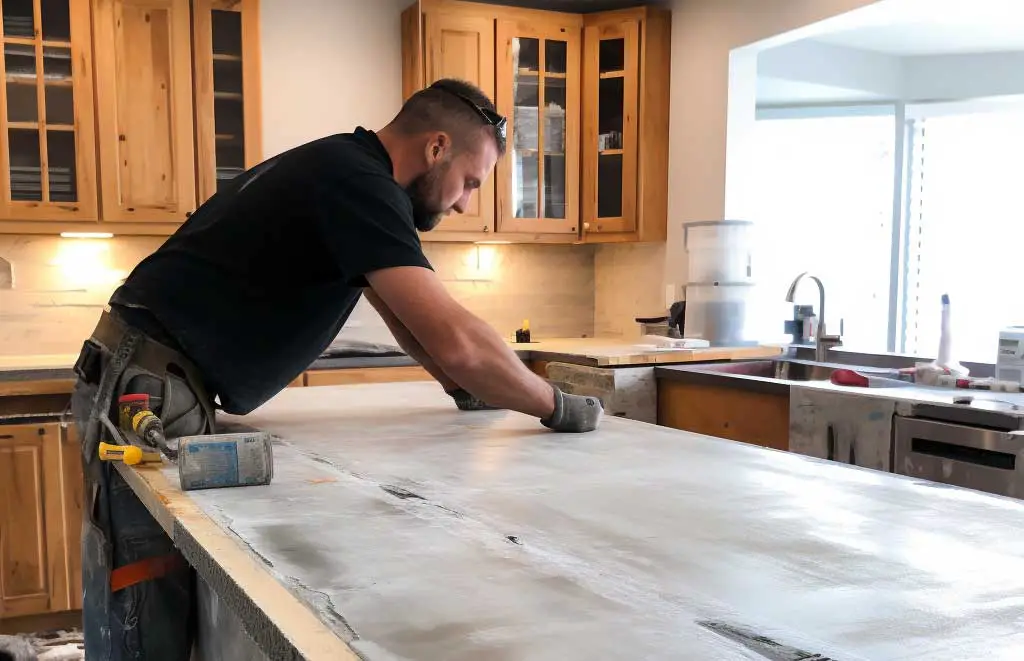
Methods to Fix Roughness
If you have rough concrete countertops, there are several methods you can use to smooth them out. Here are some of the most effective methods:
Sanding
Sanding is a popular method for smoothing rough concrete countertops. To get started, you’ll need a sanding block and a variety of grit sandpaper. Begin with a coarse grit sandpaper, such as 80 grit, and work your way up to a finer grit, such as 220 grit. Be sure to sand evenly and in a circular motion, making sure to sand the entire surface of the countertop.
Process, Tools, and Best Practices
When sanding your concrete countertops, it’s important to follow a few best practices. First, make sure to wear protective gear, such as gloves and a dust mask, to protect yourself from concrete dust. Second, use a sanding block to ensure even sanding. Third, start with a coarse grit sandpaper and gradually work your way up to a finer grit. Finally, always sand in a circular motion to avoid creating grooves in the countertop.
Applying Thin Layers or Skim Coats
Another effective method for smoothing rough concrete countertops is applying thin layers or skim coats. This involves applying a thin layer of concrete over the existing countertop to create a smooth surface. To do this, you’ll need to mix up a batch of concrete and apply it in thin layers. Start with a first coat, let it dry, and then apply a second coat. Be sure to sand in between coats to ensure a smooth finish.
How to Apply, Dry, and Sand for a Smooth Finish
To apply thin layers or skim coats to your concrete countertops, you’ll need to follow a few steps. First, mix up a batch of concrete according to the manufacturer’s instructions. Second, apply a thin layer of concrete to the countertop using a trowel. Third, let the first coat dry completely before applying a second coat. Finally, sand the surface of the countertop with a sanding block to create a smooth finish.
Using Concrete Overlays
Another option for smoothing rough concrete countertops is using concrete overlays. This involves applying a thin layer of concrete over the existing countertop to create a smooth surface. Concrete overlays are available in a variety of colors and finishes, making them a popular choice for homeowners looking to update their countertops.
Explanation and Benefits
Concrete overlays are a great option for homeowners looking to update their countertops without the expense of installing new ones. They are easy to install and can be customized to match your existing décor. Additionally, concrete overlays are durable and long-lasting, making them a great investment for your home.
Resurfacing Existing Countertops
If you have existing countertops that are rough or damaged, you may want to consider resurfacing them. This involves applying a new layer of material over the existing countertop to create a smooth surface. There are a variety of materials you can use for resurfacing, including concrete, granite, and marble.
Process, Materials, and Tips
To resurface your existing countertops, you’ll need to follow a few steps. First, clean the existing countertop thoroughly to remove any dirt or debris. Second, apply a layer of bonding agent to the countertop to help the new material adhere. Third, apply the new material in thin layers, sanding in between each layer to create a smooth finish. Finally, seal the countertop to protect it from damage.
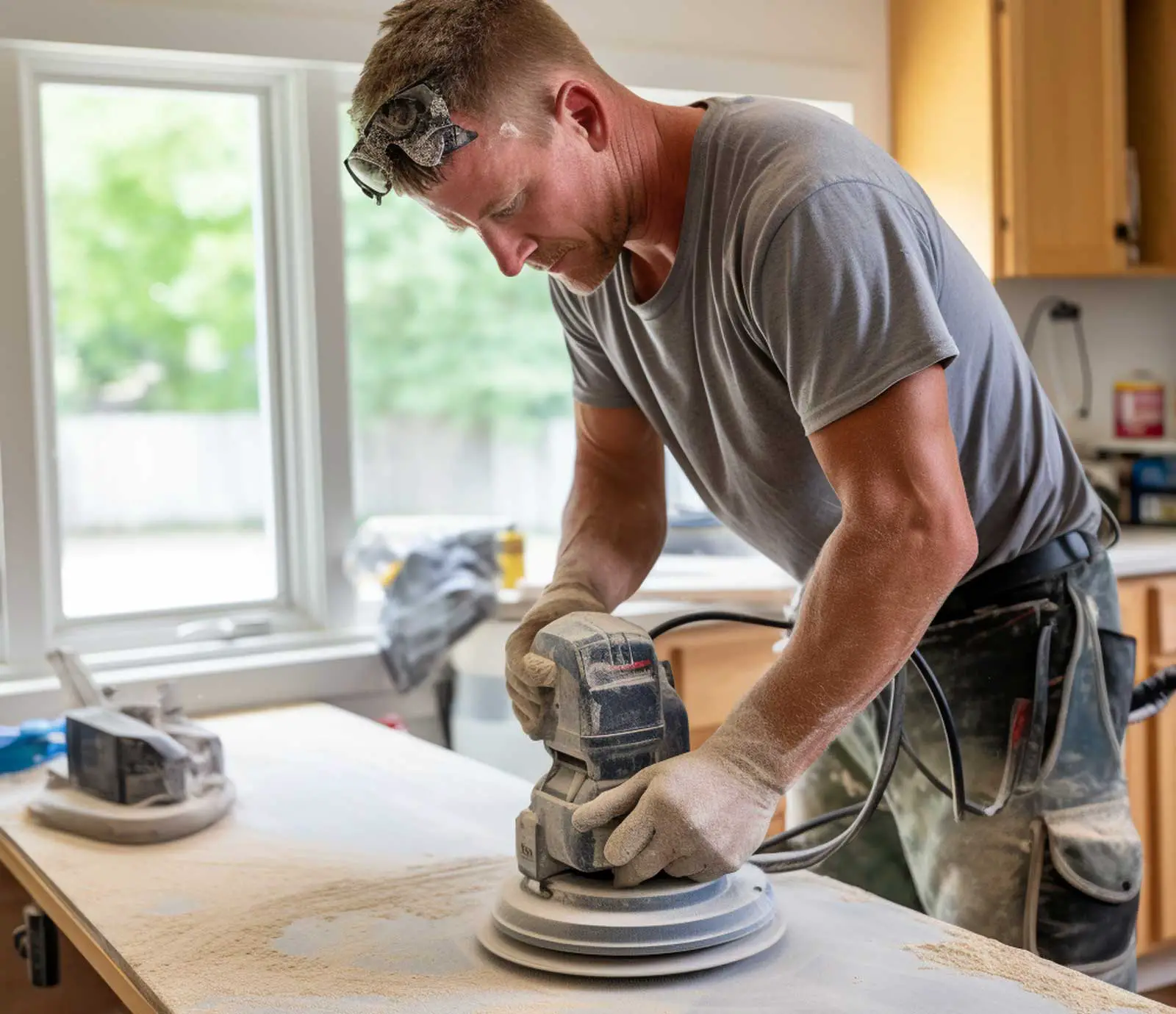
Special Considerations
When fixing rough concrete countertops, there are some special considerations to keep in mind to ensure that your repairs are successful. Here are some things to keep in mind:
Smoothing Edges and Corners
When smoothing edges and corners, it’s important to use the right techniques and tools to achieve a professional-looking finish. You can use a diamond hand pad or sandpaper to smooth out rough edges and corners. Use a circular motion to avoid creating flat spots or grooves in the surface. If you have a lot of material to remove, consider using a concrete grinder or polisher.
Techniques and Tools for Achieving a Rounded Edge
Achieving a rounded edge on your concrete countertop requires some specialized tools and techniques. You can use a diamond router bit or a hand-held diamond polishing pad to create a smooth, rounded edge. Be sure to work slowly and carefully, and use plenty of water to keep the surface cool and prevent the diamond tool from overheating.
Filling Voids, Pits, and Cracks
Before you can finish and seal your concrete countertop, you’ll need to fill any voids, pits, or cracks in the surface. You can use a vinyl patching compound or a concrete crack sealer to fill these areas. Mix the compound or sealer according to the manufacturer’s instructions, and trowel it into the cracks. Be sure to tamp the mixture to remove air pockets.
Solutions for Small Holes, Hairline Cracks, and Larger Voids
For small holes and hairline cracks, you can use a concrete patching compound or a vinyl concrete patcher. Mix the compound or patcher according to the manufacturer’s instructions, and apply it to the surface with a trowel. For larger voids, you may need to use a concrete mix. Be sure to follow the manufacturer’s instructions carefully, and mix the concrete thoroughly before applying it to the surface.
Finishing and Sealing
The final step in fixing rough concrete countertops is to finish and seal the surface. You can use an impregnator sealer to protect the surface from stains and moisture. Apply the sealer according to the manufacturer’s instructions, and be sure to use a good-quality brush or roller for even coverage. Allow the sealer to dry completely before using your countertop.
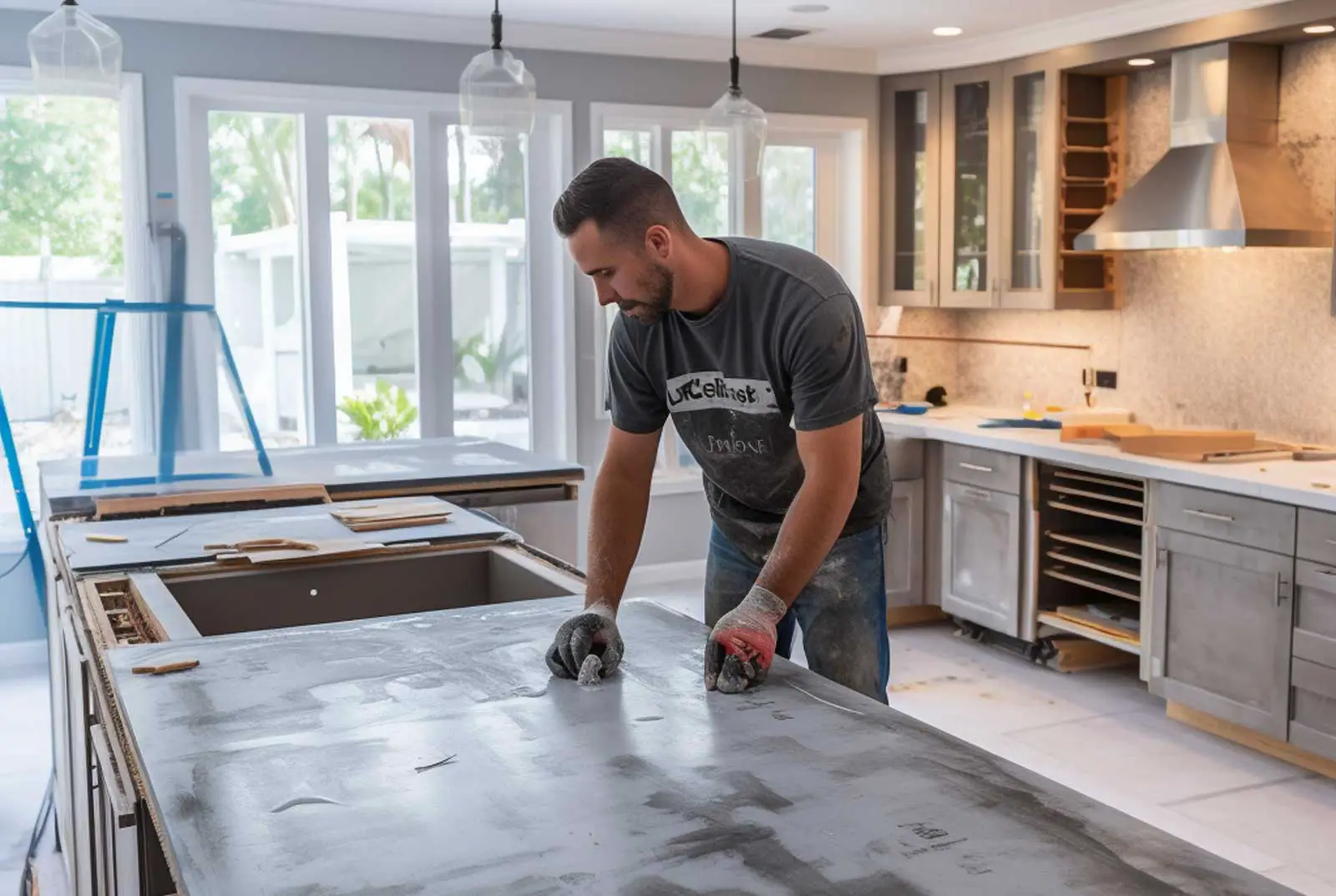
Importance of Sealing and Types of Sealers and Their Applications
Sealing your concrete countertops is crucial to protect them from stains, scratches, and other damage. Without proper sealing, your countertops will become porous and absorb liquids, leading to unsightly stains and discoloration. Additionally, unsealed concrete is more susceptible to chipping and cracking, which can be costly to repair.
There are different types of sealers available, and each has its own set of benefits and drawbacks. The most common types of sealers are topical sealers, penetrating sealers, and hybrid sealers.
Topical sealers sit on the surface of the countertop and provide a protective layer against stains and scratches. They are easy to apply and come in a range of finishes, from matte to glossy. However, topical sealers can wear off over time and may require reapplication.
Penetrating sealers, on the other hand, penetrate the concrete surface and create a chemical barrier that repels liquids. They do not change the appearance of the concrete and are long-lasting. However, they may not protect against scratches and can be more difficult to apply.
Hybrid sealers combine the benefits of both topical and penetrating sealers. They provide a protective layer on the surface of the concrete while also penetrating the surface to create a chemical barrier. Hybrid sealers are easy to apply and provide long-lasting protection against stains, scratches, and other damage.
One popular brand of concrete sealer is the Cheng Concrete Sealer. This sealer is a water-based, non-toxic sealer that is easy to apply and provides excellent protection against stains, scratches, and other damage. It is available in both matte and gloss finishes and can be used on both indoor and outdoor concrete surfaces.
When choosing a sealer for your concrete countertops, consider the level of protection you need, the appearance you want, and the ease of application. With the right sealer, you can protect your countertops and keep them looking beautiful for years to come.
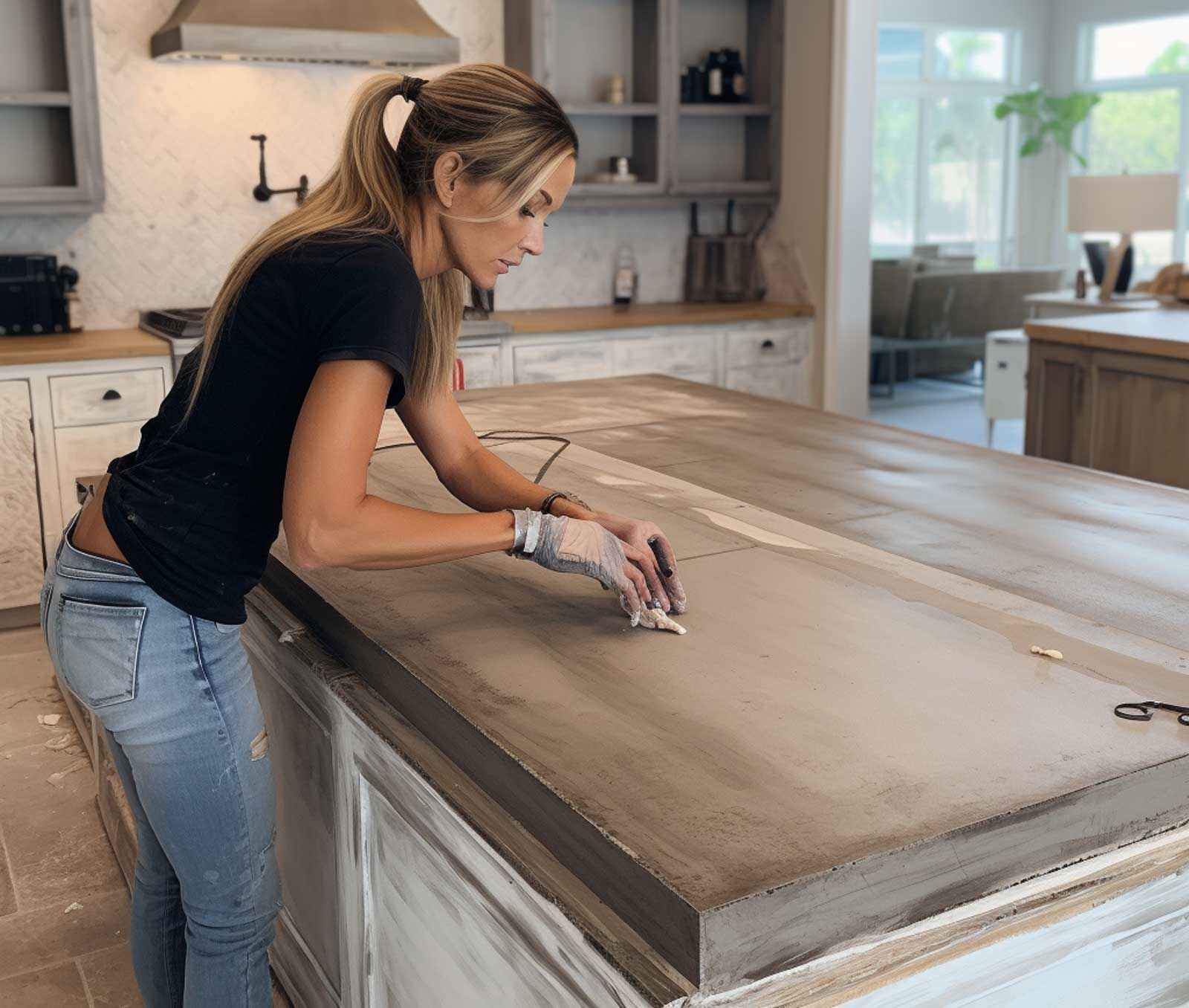
Maintenance and Care
Concrete countertops are a durable and stylish addition to any kitchen or bathroom. However, like any other surface, they require proper maintenance and care to ensure they remain in good condition. Here are some tips to help you keep your concrete countertops looking their best.
Tips for Daily Care
To keep your concrete countertops looking their best, it’s important to clean them regularly. You can use a mild, pH-neutral cleaner and a soft cloth or sponge to wipe down the surface. Avoid using abrasive cleaners or scrubbers, as they can scratch the surface of the concrete.
In addition to regular cleaning, it’s important to avoid placing hot pots or pans directly on the countertop. Use trivets or hot pads to protect the surface from heat damage. You should also avoid cutting directly on the countertop, as this can scratch the surface.
Preventing Stains
Concrete countertops are porous, which means they can absorb liquids and stains if they’re not properly sealed. To prevent stains, it’s important to seal your concrete countertops regularly. You can use a penetrating sealer to protect the surface from spills and stains.
If you do spill something on your concrete countertop, it’s important to clean it up immediately. Use a soft cloth or sponge to blot up the spill, and avoid rubbing or scrubbing the surface, as this can push the stain deeper into the concrete.
Enhancing Longevity
To enhance the longevity of your concrete countertops, it’s important to take steps to protect them from damage. You can use cutting boards and trivets to protect the surface from scratches and heat damage.
It’s also important to avoid using harsh chemicals or abrasive cleaners on your concrete countertops. These can damage the surface and cause it to deteriorate over time. Instead, use a mild, pH-neutral cleaner and a soft cloth or sponge to clean the surface.
By following these tips, you can keep your concrete countertops looking their best for years to come.
Cost Considerations and DIY Tips
Breaking Down the Costs and Offering Tips for DIY Enthusiasts
Fixing rough concrete countertops can be a cost-effective solution compared to replacing them. The cost of fixing rough concrete countertops depends on the extent of the damage and the method used to fix them. Here’s a breakdown of the costs and some DIY tips for enthusiasts:
Cost Breakdown
The cost of fixing rough concrete countertops can range from $10 to $50 per square foot, depending on the extent of the damage and the method used to fix them. If you’re hiring a professional to fix your countertops, the cost can go up to $100 per square foot.
If you’re planning to fix the countertops yourself, the cost can be significantly lower. You can buy a concrete patching compound for as low as $10 per bag at Home Depot or other hardware stores. However, if you’re planning to use a concrete overlay, the cost can go up to $50 per bag.
DIY Tips
If you’re a DIY enthusiast, fixing rough concrete countertops can be a fun and rewarding project. Here are some tips to help you get started:
- Before you start fixing your countertops, make sure they’re clean and dry. Use a wire brush to remove any loose concrete or debris.
- If you’re using a concrete patching compound, mix it according to the manufacturer’s instructions. Apply the compound to the damaged area with a trowel and smooth it out.
- If you’re using a concrete overlay, mix it according to the manufacturer’s instructions. Apply the overlay to the countertop with a trowel and use a concrete float to smooth it out.
- Let the patching compound or overlay dry for at least 24 hours before using the countertop.
- If you’re planning to apply a sealer to your countertops, make sure it’s compatible with the patching compound or overlay you used.
By following these tips, you can fix rough concrete countertops and give them a new lease on life. Plus, you’ll save money and have the satisfaction of doing it yourself.
FAQ Section
How Long Do Concrete Countertops Last?
Concrete countertops are known for their durability and longevity. With proper care and maintenance, they can last for decades. However, the lifespan of a concrete countertop depends on several factors, including the quality of the concrete mix, the installation process, and the level of use and wear and tear over time. On average, a well-made concrete countertop can last up to 30 years or more.
How Can I Resurface My Countertops Without Replacing Them?
If your concrete countertops are rough or damaged, resurfacing them is a great way to give them a fresh new look without having to replace them entirely. To resurface your countertops, you’ll need to follow these steps:
- Clean the surface of your countertops thoroughly.
- Sand the surface of the countertops with a fine-grit sandpaper to remove any rough spots or imperfections.
- Apply a thin layer of concrete overlay to the surface of the countertops using a trowel or putty knife.
- Smooth out the surface of the overlay with a float or trowel, and let it dry completely.
- Sand the surface of the overlay with a fine-grit sandpaper to smooth out any rough spots or imperfections.
- Apply a sealer to the surface of the countertops to protect the overlay and give it a glossy finish.
What Kind of Sandpaper Should I Use on Concrete Countertops?
When sanding concrete countertops, it’s important to use the right kind of sandpaper to avoid damaging the surface of the concrete. For rough sanding, use a coarse-grit sandpaper, such as 80-grit or 100-grit. For smoothing out rough spots or imperfections, use a fine-grit sandpaper, such as 220-grit or 320-grit.
How Do You Fix Ghosting in Concrete Countertops?
Ghosting is a common problem with concrete countertops that occurs when the surface of the countertop becomes discolored or stained in certain areas. To fix ghosting in concrete countertops, you’ll need to follow these steps:
- Clean the surface of the countertop thoroughly.
- Sand the surface of the countertop with a fine-grit sandpaper to remove any rough spots or imperfections.
- Apply a concrete stain or dye to the surface of the countertop to even out the color.
- Apply a sealer to the surface of the countertop to protect it from future staining.
What Is Ghosting in Concrete?
Ghosting in concrete refers to a discoloration or staining of the surface of the countertop that occurs in certain areas. This can be caused by a variety of factors, including exposure to sunlight, heat, or moisture, as well as improper sealing or finishing of the surface of the countertop.
Can You Reseal Concrete Countertops?
Yes, you can reseal concrete countertops to protect them from staining and other damage. To reseal your countertops, you’ll need to follow these steps:
- Clean the surface of the countertops thoroughly.
- Sand the surface of the countertops with a fine-grit sandpaper to remove any rough spots or imperfections.
- Apply a concrete sealer to the surface of the countertops using a brush or roller.
- Let the sealer dry completely before using the countertops.
How Do You Keep Concrete Countertops from Staining?
To keep concrete countertops from staining, it’s important to clean up spills and messes as soon as possible. You should also avoid placing hot or wet items directly on the surface of the countertop, as this can cause discoloration or staining. Additionally, you can use a penetrating sealer to protect the surface of the countertop from staining.
What Is the Best Filler for Concrete Countertops?
The best filler for concrete countertops depends on the type of damage or imperfection you’re trying to fix. For small cracks or holes, a concrete patching compound or vinyl concrete patcher can be used. For larger cracks or holes, an epoxy filler or concrete overlay may be necessary.
Can You Put Epoxy over Concrete Countertops?
Yes, you can put epoxy over concrete countertops to give them a glossy, durable finish. To apply epoxy to your countertops, you’ll need to follow these steps:
- Clean the surface of the countertops thoroughly.
- Sand the surface of the countertops with a fine-grit sandpaper to remove any rough spots or imperfections.
- Apply a thin layer of epoxy to the surface of the countertops using a brush or roller.
- Let the epoxy dry completely before using the countertops.
Do You Have to Seal Cement Countertops?
Yes, it’s important to seal cement countertops to protect them from staining and other damage. A penetrating sealer is recommended for cement countertops, as it will soak into the
